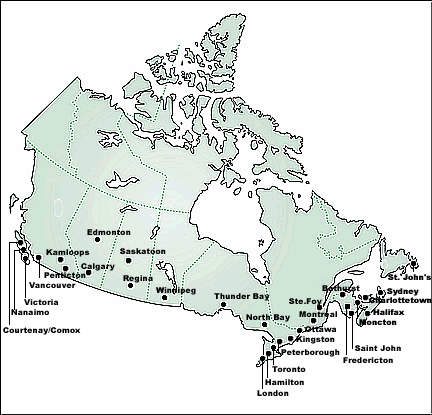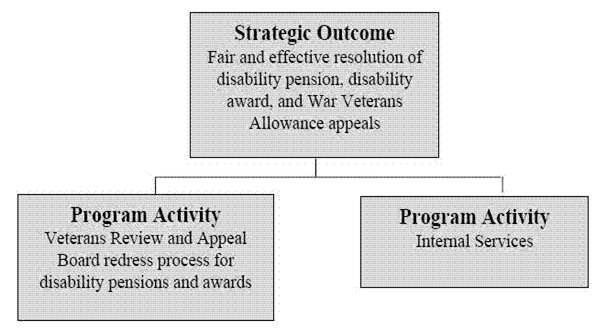Common menu bar links
Breadcrumb Trail
ARCHIVED - Veterans Review and Appeal Board - Report
 This page has been archived.
This page has been archived.
Archived Content
Information identified as archived on the Web is for reference, research or recordkeeping purposes. It has not been altered or updated after the date of archiving. Web pages that are archived on the Web are not subject to the Government of Canada Web Standards. As per the Communications Policy of the Government of Canada, you can request alternate formats on the "Contact Us" page.
Chair's Message

I am pleased to present the 2011-2012 Report on Plans and Priorities for the Veterans Review and Appeal Board.
The Veterans Review and Appeal Board is an independent, quasi-judicial tribunal that fulfills an important role within Canada's disability benefits system for Veterans, Canadian Forces members, Royal Canadian Mounted Police members and their families. Throughout the year, in locations across the country, our members hear and make decisions on applications for review and appeal of disability decisions rendered by Veterans Affairs Canada. As Canadians, they carry out this work with a strong sense of the responsibility inherent in the Board's mandate to those who have served – and continue to serve – their country. As adjudicators, they are often faced with difficult human situations and complex issues in making decisions.
The role of our Board members is to determine whether the laws governing the disability benefits programs for Veterans and other applicants have been properly applied by Veterans Affairs Canada in individual cases. To accomplish this, they conduct hearings where they listen to applicants' testimony and/or arguments from representatives and consider new evidence; interpret and apply the legislation based on the evidence; and render written decisions with reasons for their rulings. In making these decisions, Board members are required by law to resolve any doubt in favour of applicants. While the Board is not able to rule favourably in all cases, it makes every effort to issue a fair and well-reasoned decision for each applicant.
As Chair of the Board, I recognize that applicants expect, and deserve, an effective appeal process. The Board is constantly working to make improvements to its program without sacrificing quality decision-making. We also support our members through ongoing training, regular dialogue as a membership and access to expertise from staff in legal services and quality assurance roles.
For 2011-2012, the Board's activities will continue to be guided by the following priorities:
- To provide applicants with the opportunity to be heard at the earliest opportunity and to issue fair and timely decisions;
- To consider opportunities to further simplify our processes in order to improve service to applicants;
- To communicate more with applicants and Canadians; and
- To deliver an effective program by focussing on management, transparency and accountability.
In closing, I would like to invite you to read this first stand-alone Report on Plans and Priorities for the Board. In the past, the Board's information was presented to Parliament in a portfolio-wide report for Veterans Affairs. A recent change in our Program Activity Architecture requires us to report separately from Veterans Affairs Canada.
We look forward to meeting the challenges ahead as we continue to fulfill our mandate as an independent appeal tribunal for the benefit of applicants and all Canadians.
John D. Larlee
Chair, Veterans Review and Appeal Board
Section 1 - Overview
Raison d'être
The Veterans Review and Appeal Board is an independent, quasi-judicial tribunal created in 1995 by the Veterans Review and Appeal Board Act. The Board provides an appeal process for service-related disability decisions made by Veterans Affairs Canada.
The Pension Act governing disability benefits for Canada’s Veterans came into effect after the First World War in 1919. An appeal process, with several variations, has been in place since 1923 to address the concerns of dissatisfied applicants. From 1971, the final level of appeal has been in the hands of an agency independent from the Department of Veterans Affairs. Since 1995, the final two levels of appeal have been vested in the Board.
The Veterans Review and Appeal Board’s objective is to ensure that Canada’s traditional Veterans, Canadian Forces members and Veterans, Royal Canadian Mounted Police members,qualified civilians and their families receive the disability pensions, disability awards and other benefits to which they are entitled under the law.
Mandate
The Veterans Review and Appeal Board has full and exclusive jurisdiction to hear, determine and deal with all applications for review and appeal that may be made to the Board under the Pension Act, the Canadian Forces Members and Veterans Re-establishment and Compensation Act - Part 3, the War Veterans Allowance Act and other Acts of Parliament. All matters related to appeals under this legislation are authorized under the Veterans Review and Appeal Board Act.
The Board also adjudicates disability pension applications under the authority of the Royal Canadian Mounted Police Pension Continuation Act and the Royal Canadian Mounted Police Superannuation Act.
Organization
The adjudicative role of the Board is carried out by a complement of members. As legislated by sections 4 and 6 of the Veterans Review and Appeal Board Act, not more than 29 permanent members may be appointed by the Governor in Council and, based on the Board’s workload, any number of temporary members. The Board’s offices are centralized in Charlottetown where all staff are located to support the adjudicative process. Approximately one-half of the members are located in Charlottetown and the remainder are located in major cities across Canada.
Responsibilities
The Veterans Review and Appeal Board provides applicants with two levels of redress for disability pension and disability award decisions and the final level of appeal for War Veterans Allowance applications.
The Board liberally construes and interprets the legislation to fulfill the obligation of the people and the Government of Canada to those who have served their country so well.
The Board can review Veterans Affairs Canada’s decisions related to:
- - Disability pensions or awards.
- - Special awards, including Attendance Allowance, Exceptional Incapacity Allowance and Clothing Allowance.
- - Dependent/survivor benefits.
- - War Veterans Allowance appeals.
The first level of redress is the review hearing. It provides applicants the opportunity for an in-person hearing before two members of the Board.
The second level of redress is the appeal hearing where cases are heard by three members who were not involved in the review hearing.
The Board may affirm, vary or reverse decisions made by Veterans Affairs Canada or refer decisions back to Veterans Affairs Canada for reconsideration.
The Board ensures benefits to Canadians in these ways:
- - Gives applicants the right to have their decision reviewed by an independent tribunal.
- - Conducts hearings where individuals may appear before the decisionmakers, tell their story, and bring witnesses.
- - Gives applicants the benefit of doubt in the weighing of evidence and is responsible to resolve any doubt in their favour.
- - Is non-adversarial.
- - Has no time limits.
The Board carries out its work with a strong sense of responsibility to those who protect Canadian values.
Hearing Locations
The Veterans Review and Appeal Board will continue to travel to approximately 30 locations to conduct review hearings and will also convene hearings in other locations where there is sufficient demand. The Board also provides videoconference hearings upon request. Appeal hearings are usually held in Charlottetown.

Applicant Profile in 2009-2010

Program Activity Architecture
The Veterans Review and Appeal Board’s Program Activity Architecture (PAA), approved by Treasury Board in June 2010, is shown below. Based on the Board’s legislated mandate, the PAA consists of one strategic outcome and two program activities that support the strategic outcome. The performance information presented in Section II is organized according to this structure.

Program Activity Architecture Crosswalk
The Veterans Review and Appeal Board’s Program Activity Architecture (PAA) was modified for the 2011-12 fiscal year to create a separate PAA for the Board. Previously, the Board was included as a Program Activity within Veterans Affairs Canada’s PAA although it always functioned as an independent agency and at arm’s length from Veterans Affairs Canada. The funds in the Board’s distinct Vote are now allocated directly to the Board through the creation of its own PAA.
Planning Summary
| 2011–12 | 2012–13 | 2013–14 |
|---|---|---|
| 11.5 | 11.5 | 11.5 |
| 2011–12 | 2012–13 | 2013–14 |
|---|---|---|
| 121 | 121 | 121 |
| Performance Indicator | Target |
|---|---|
| Percentage of client concerns that are effectively responded to | 80 percent of complaints are responded to within 60 days |
| Program Activity | Forecast Spending 2010–11 |
Planned Spending | Alignment to Government of Canada Outcomes |
||
|---|---|---|---|---|---|
| 2011–2012 | 2012–2013 | 2013–2014 | |||
| Veterans Review and Appeal Board redress process for disability pensions and awards | 11.7 | 11.5 | 11.5 | 11.5 | Income Security and Employment for Canadians |
Internal Services
Internal Services to support the operations of the Veterans Review and Appeal Board are provided by Veterans Affairs Canada through its Vote 1 - Operating Expenditures.
Contribution of Priorities to Strategic Outcomes
The Veterans Review and Appeal Board has three operational priorities and one management priority which link to the Board’s strategic outcome. The operational priorities outline the planned actions to be taken to improve the delivery of the Board’s program in order to achieve better results for Canadians. The management priority is focussed on improving internal practices and controls in order to strengthen overall performance. The following tables link the Board’s operational and management priorities with its strategic outcome and program activities.
| Operational Priority: | Type | Strategic Outcome |
|---|---|---|
| Program Delivery | Ongoing | Fair and effective resolution of disability pension, disability award, and War Veterans Allowance appeals |
|
Why is this a priority? It ensures applicants have an avenue of redress by an independent tribunal for disability compensation and War Veterans Allowance applications. Plans for meeting the priority
|
||
| Operational Priority: | Type | Strategic Outcome |
|---|---|---|
| Improved program Delivery | Ongoing | Fair and effective resolution of disability pension, disability award, and War Veterans Allowance appeals |
|
Why is this a priority? Enhancing program delivery through innovation and use of technology improves the process for applicants. Plans for meeting the priority
|
||
| Operational Priority: | Type | Strategic Outcome |
|---|---|---|
| Communication | Ongoing | Fair and effective resolution of disability pension, disability award, and War Veterans Allowance appeals |
|
Why is this a priority? It ensures applicants and all Canadians have information on the Board's mandate, program, and redress process, while meeting the increasing information needs of applicants. Plans for meeting the priority
|
||
| Management Priority: | Type | Strategic Outcome |
|---|---|---|
| Accountable management | Ongoing | Fair and effective resolution of disability pension, disability award, and War Veterans Allowance appeals |
|
Why is this a priority? To provide an effective program for applicants and their families by focussing on management, transparency and accountability. Plans for meeting the priority
|
||
Risk Analysis
The Veterans Review and Appeal Board operates in an adjudicative environment where the volume of applications for hearings is difficult to predict. In 2009-10, the Board finalized 5688 decisions which was down in comparison to the previous year. Despite workload indicators such as the volume of Veterans Affairs Canada decisions, forecasting the workload remains challenging due to factors such as the operational tempo of the Canadian Forces.
There are continual pressures to shorten wait times for hearings. Although the Board continues to seek opportunities for efficiencies, they are becoming increasingly limited. The Board does not control the time applicants take to prepare their case. Legal arguments and medical interrelationships are increasingly complex and will continue to evolve.
The Board is also under more and more pressure to provide additional information on its program. The changes in applicant demographics and increasing expectations that have stimulated Veterans Affairs Canada to pursue a transformation agenda are also a reality for the Board. As well, the Board is responding to additional reporting to central agencies as a result of reporting as a separate agency.
Collectively, these circumstances present challenges in terms of planning, implementing new initiatives and assigning limited resources.
To identify and mitigate risks that may impact its program, the Board has in place key elements to ensure good governance, management and accountability. These include a strategic plan, a rigorous annual risk assessment, and quarterly business meetings that take into account operational priorities, human and financial resources, and performance measures.
Board members engage in ongoing professional development through training sessions, conferences, workshops and reference tools. The Board actively monitors its workload and continually refines its annual hearing schedule so that cases can be brought forward to a hearing at the earliest opportunity. Plans are in place to carry out a comprehensive review of the Board’s processes to identify further opportunities to improve program delivery and access for applicants. Work is underway to enhance the content of the Web site to ensure more open communication about the Board’s appeal process for applicants. The Board is also undertaking an in-depth authorities review to ensure it has all the policies and agreements in place to operate effectively and in accordance with central agency requirements.
Expenditure Profile
Veterans Review and Appeal Board Spending Trend
| 2011-12 Planned |
2012-13 Planned |
2013-14 Planned |
|
|---|---|---|---|
| Totals | 11.5 | 11.5 | 11.5 |
Planned spending for the Veterans Review and Appeal Board is expected to remain constant over the three-year planning period. The 2011-12 Report on Plans and Priorities is the first stand-alone report for the Board. Spending for previous years has been reported as part of the Veterans Affairs Portfolio.
Estimates by vote
For information on our organizational votes and/or statutory expenditures, please see the 2011–12 Main Estimates publication. An electronic version of the Main Estimates is available at http://www.tbs-sct.gc.ca/est-pre/2011-2012/me-bpd/info/info-eng.asp.
